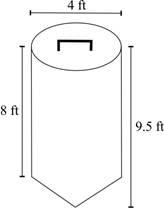A company that manufactures storage bins for grains made a drawing of a silo. The silo has a conical base, as shown below: The figure shows a silo shaped as a closed cylinder with a conical end. The diameter of the silo is 4 ft, the length of the cyl Which of the following could be used to calculate the total volume of grains that can be stored in the silo? (6 points) π(2ft)2(8ft) + one over three π(2ft)2(9.5ft − 8ft) π(8ft)2(2ft) + one over three π(2ft)2(9.5ft − 8ft) π(2ft)2(8ft) + one over three π(9.5ft − 8ft)2(2ft) π(8ft)2(2ft) + one over three π(9.5ft − 8ft)2(2ft)
omai that's a lot of 🥧 Jokes aside, the volume of a cylinder usually operates off this formula:\[V_{cylinder}=\pi r^2h\]and the volume of a cone usually operates off this other formula:\[V_{cone}=\frac{1}{3}\pi r^2h\]To get a "conical cylinder" (i.e. the whole shape of your silo here) we would use either this unnecessarily complicated format or the ultimate formula below:\[\Large{V_{silo}=\pi r^2h+\frac{1}{3}\pi r^2h}\]
omg
Indeed, a lot of 🥧
I cant lol
Is the answer B?
There was so much that I walked in the door and got pied immediately. 😩
because thats what I got
...hold on I have to parse the question... why is it phrased so complicated? 💀
So this is what you're given and they expect you to calculate a whole volume formula off this? Smh |dw:1619621949824:dw|
what 8?
Oh wait I forgot the other part. The length of the cylinder is also the diameter. Gotcha|dw:1619622085386:dw|No idea what the cone's height is though
Are there any other values given? It looks like your question got cut-off here
im sorry, I didn't pout the picture up
OOH. Okay that helps a lot. Except that is one weirdly shaped silo... when do the cones point down? Anyway... back to the pie party.
So we have the diameter as 4 feet, the cylinder height as 8 feet and the silo's height as 9.5 feet. First let's convert the diameter value into a format suited for the area of the base. The silo has only one base shape (a circle) that goes with both the cylinder and the cone, so: Our radius will be half of the diameter, or \(r=2ft\). So the base should be \(B=\pi(2ft)^2\) Moving on, we look at the volumes of each section of the silo. The cylinder's height, as previously stated, is \(8ft\) so the volume should be\[V_{cylinder}=\pi(2ft)^2(8ft)\]As for the cone, we don't have the exact height for that but we can calculate it! You have the full silo height and the cylinder's height, so a little subtraction should work here. And so the cone volume would be:\[V_{cone}=\frac{1}{3}\pi(2ft)^2(9.5ft-8ft)\]Adding those together, we would get:\[V_{silo}=V_{cylinder}+V_{cone}=\pi(2ft)^2(8ft)+\frac{1}{3}\pi(2ft)^2(9.5ft-8ft)\]
Actually, that would make your answer A.
thank you
:-) No problem!
Join our real-time social learning platform and learn together with your friends!


